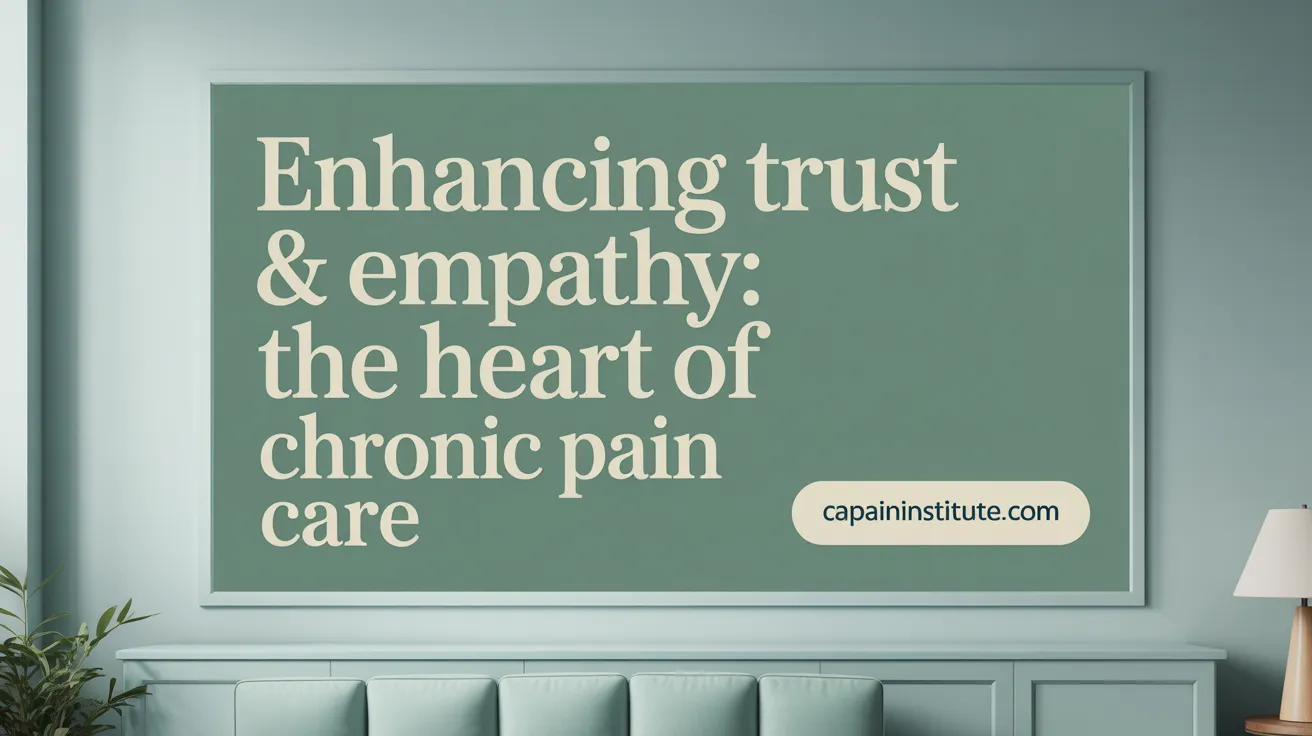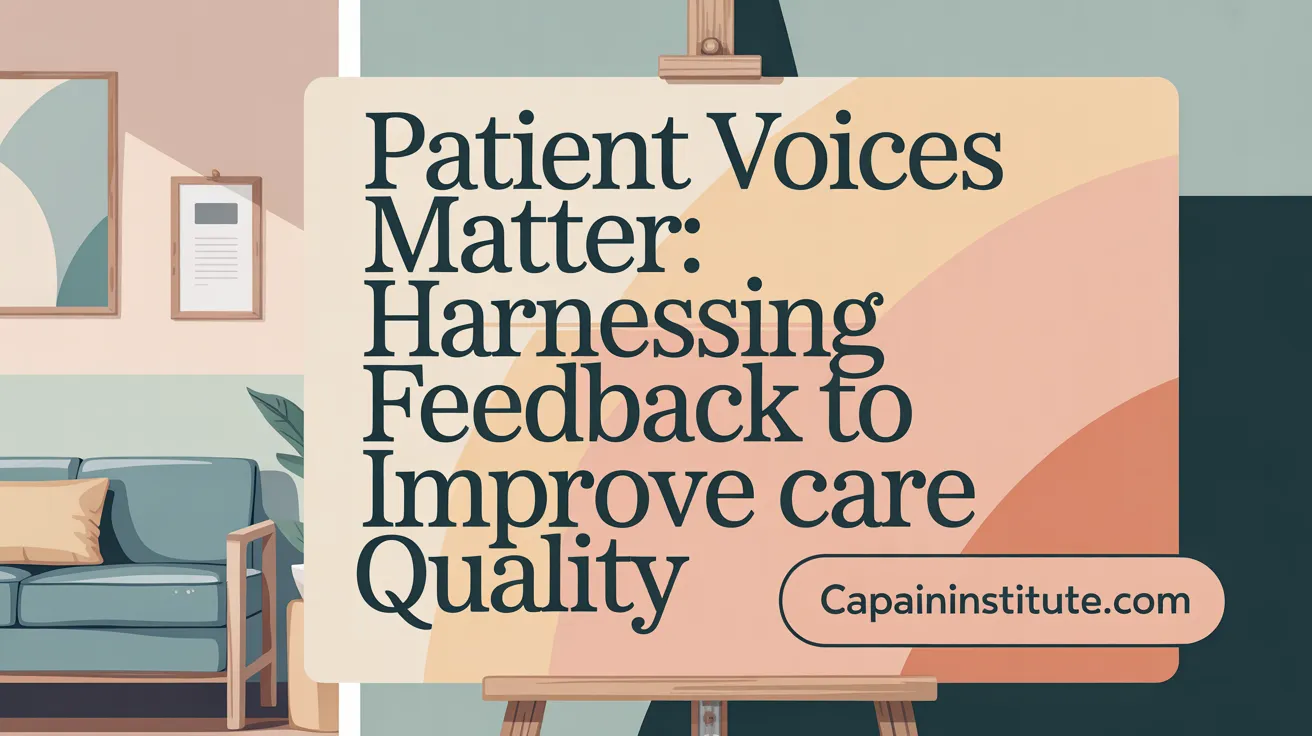Introduction to Chronic Pain and Patient Experience
Chronic pain affects an estimated 20% of the population worldwide, profoundly impacting individuals' physical, emotional, and social lives. The journey from persistent pain to progress and management is deeply personal and complex. This article explores inspiring patient experiences, showcasing how innovative treatments, patient-centered care, and supportive healthcare systems can empower those living with chronic pain to reclaim their lives. By illuminating these stories and insights, we aim to provide hope, understanding, and guidance for patients and care providers alike.
Understanding the Patient Experience in Chronic Pain Care

What defines patient experience and why is it important in healthcare?
Patient experience refers to the entirety of interactions patients have with healthcare systems, shaped by the organization’s culture and impacting how patients perceive their care across all stages. This includes communication, empathy, respect, and the overall atmosphere patients encounter (Defining Patient Experience, Patient experience in healthcare, Patient Experience).
Why are empathy, communication, and respect crucial?
In chronic pain care, these elements become vital. Patients often face disbelief or neglect, which can worsen their condition or emotional distress. Positive interactions where patients are listened to, believed, and treated respectfully foster trust and hope, significantly improving adherence and outcomes (Living with chronic pain, Patient Experience).
How do healthcare providers influence patient perceptions?
Healthcare professionals shape patient experiences by showing empathy, concern, and thoroughness. They coordinate care, provide emotional support, and ensure patients feel acknowledged. This is especially important in managing chronic pain, where understanding a patient's lived experience improves personalized care (Patient experience and organizational culture, Chronic Pain Journey Map).
What tools measure patient experience?
Programs like CAHPS and HCAHPS offer standardized surveys that capture patient feedback on communication, respect, and overall experiences. These tools help health organizations identify strengths and areas needing improvement to enhance care quality (Patient Experience Measurement, HCAHPS measurement tool).
How are diverse populations included in patient experience assessments?
Recognizing the unique experiences of children, elderly, minority groups, rural residents, and those with special needs is a priority. Inclusive assessment ensures all demographic groups have their voices heard, allowing tailored interventions and equitable care (Inclusive Patient Experience Assessment, Improving patient experience in primary care).
Chronic Pain: The Invisible Journey and Its Impact
Prevalence and challenges of chronic pain
Chronic pain affects about 20% of the population and remains a significant health challenge. It is often invisible, making it difficult for others to understand or empathize with the sufferer's experience. This invisibility leads to unique challenges in healthcare and daily life. For more on this, see Chronic pain statistics and Living with chronic pain.
Emotional distress and functional disability
Living with chronic pain causes profound emotional distress and functional disability. Patients frequently battle feelings of isolation, frustration, and anxiety. Pain restricts physical abilities, disrupts social life, and can diminish overall quality of life. This complexity is detailed in the Biopsychosocial model of pain and impact of chronic pain.
Patients’ feelings of acknowledgment vs. neglect
Experiences with healthcare vary widely; some patients feel acknowledged—listened to, believed, and supported—while others report feeling neglected and invalidated. The difference in these experiences profoundly affects emotional well-being and pain outcomes. Explore Patient experience in healthcare, and Improving patient experience through empathy.
The biopsychosocial model of pain
Pain is not just a physical sensation but a complex interaction of physical, cognitive, emotional, behavioral, and social factors. This Biopsychosocial model of pain emphasizes the need to consider all aspects impacting pain rather than focusing solely on symptoms. For more, see Biopsychosocial model of pain and Chronic pain journey map.
Importance of person-centered care
Addressing chronic pain effectively requires a person-centered approach that respects individual values, expectations, and lived experiences. Collaborative care that includes emotional support alongside medical treatments improves adherence and quality of life. See details on Person-centred care importance and Collaborative chronic pain care.
How does living with chronic pain affect patients emotionally and physically?
Chronic pain leads to significant emotional distress, social isolation, and functional disability. Patients often feel invisible and misunderstood, experiencing both acknowledgment and neglect in healthcare. The Biopsychosocial model of pain highlights that pain is influenced by physical, cognitive, emotional, behavioral, and social factors. Person-centered care that respects patient values and experiences is essential for effective pain management. More on this can be found in Understanding chronic pain experience and Living with Multiple Chronic Conditions.
Innovative Approaches to Self-Management and Treatment
What role does self-management and goal setting play in chronic pain treatment?
Self-management is a cornerstone in the treatment of chronic pain, enabling patients to actively engage in their care journey. It emphasizes personalized strategies, where individuals set specific goals that help create concrete action plans tailored to their unique pain experiences. This approach not only empowers patients but also fosters greater adherence and motivation. For more detailed insights, see Self-management for chronic pain.
How do digital tools facilitate goal creation and progress tracking?
Advancements in technology have introduced digital tools designed to assist people with chronic pain. These platforms guide users through the process of setting realistic and meaningful goals, monitoring progress systematically, receiving targeted feedback, and reflecting on treatment outcomes. The integration of these tools supports continuous engagement and helps patients stay accountable in managing their condition. Learn more about Digital tool for chronic pain.
What is the role of interdisciplinary pain management programs?
Interdisciplinary programs offer a holistic treatment model by combining expertise from medical doctors, psychologists, physical therapists, and occupational therapists. Such comprehensive care frameworks prioritize active patient participation and self-management techniques. Patients learn strategies to control pain, understand psychological factors influencing their condition, and regain confidence in movement and everyday activities. Explore details of the Interdisciplinary pain management programs.
Can you provide examples of active patient participation?
Programs like the Shirley Ryan AbilityLab Pain Management Center exemplify successful interdisciplinary approaches. Patients participate in intensive four-week programs that include physical therapy modalities such as chair yoga and water aerobics, psychological education to alter pain perceptions, and community support networks. These initiatives increase patients' sense of safety and ownership over their lives, encouraging sustained recovery and improved quality of life. Read more about Megan's Story with Chronic Pain.
Real Patient Journeys: Stories of Resilience and Recovery
How do patient stories illustrate the journey from pain to progress?
Patient stories reveal that recovery from chronic pain is often about managing symptoms and improving life quality rather than complete elimination of pain. For instance, Megan H. faced multiple chronic conditions causing persistent pain but found renewed confidence and movement through a comprehensive four-week pain program. This interdisciplinary approach, involving physical therapy, occupational therapy, pain psychology, and community support, empowered her with self-management techniques and a new outlook.
Similarly, Tracie’s story demonstrates how personalized, non-narcotic treatments at a chronic pain clinic helped her overcome opioid dependence and regain a normal life. The clinic used a multidisciplinary approach, including psychological support and various therapies, tailored to her unique needs.
These patient journeys highlight the impact of compassionate and individualized care, emphasizing that recovery often means reclaiming function, managing flare-ups, and mental adjustment rather than pain eradication.
Impact of personalized and compassionate treatment
Personalized care that considers physical, psychological, and social factors can markedly improve patients’ experiences and outcomes based on the biopsychosocial model of pain. Peggy Guin’s story shows how an individualized diagnosis and procedure—radiofrequency ablation—provided her with about 80% pain relief and restored active living. The multidisciplinary teams featured in many stories underscore the importance of engaging patients as active participants in their care.
Recovery beyond absence of pain
Recovery is more than pain reduction; it encompasses emotional resilience and functional improvement. Stories like Annie’s demonstrate that recovery means making efforts to live meaningfully despite pain. These journeys often include developing coping strategies, motivation, and hope.
Role of patient testimonials
Authentic patient testimonials play a pivotal role in building trust and motivation for both patients and healthcare providers. Sharing stories of perseverance and recovery fosters hope and validates treatment approaches. Testimonials can be presented in written or video formats and are valuable tools to enhance patient engagement and confidence in care, as described in patient testimonials examples.
These real-life examples collectively illustrate that the chronic pain journey is complex but manageable with appropriate, holistic, and compassionate care.
Addressing Gaps and Pain Points in Patient Journey Mapping

Stages and touchpoints in the chronic pain patient journey
The chronic pain patient journey maps out critical stages: awareness of pain, accessing care, receiving services, and ongoing management. Each phase features multiple touchpoints where patients interact with healthcare providers and systems, including initial diagnosis, treatment planning, therapy sessions, and follow-ups (Chronic Pain Journey Map.
Common pain points like access, communication, and follow-up
Patients with chronic pain often face barriers such as difficulty securing timely appointments, long wait times, unclear communication about treatment options and costs, and insufficient follow-up care. Limited access to care specialists and coordination between providers also contributes to patient frustration and suboptimal outcomes (digital appointment booking systems).
Role of patient journey maps in improving care quality
Patient journey mapping provides a visual and analytical tool to uncover and understand these pain points systematically. It identifies gaps and breaks down barriers within each stage, guiding healthcare organizations to implement targeted solutions that enhance patient satisfaction and health outcomes (Patient Journey Mapping).
Use of digital systems for appointment booking and real-time updates
Integrating digital tools such as online appointment booking platforms and real-time wait-time updates via SMS or mobile apps has greatly improved patient convenience and transparency. These technologies empower patients with greater control while reducing anxiety related to access and delays (digital appointment booking systems.
Building provider-patient trust through personalized care
Personalized communication and continuity of care strengthen the provider-patient relationship. When patients feel listened to and receive clear information tailored to their needs, trust builds. This foundation fosters better engagement, adherence to treatment, and overall care experience (patient experience.
What are the main patient journey pain points and how can they be addressed?
Key patient journey pain points include:
- Difficulties in access and scheduling timely appointments
- Lengthy wait times and lack of real-time information
- Poor communication regarding treatments, costs, and care plans
- Insufficient follow-up and unclear instructions post-visit
- Financial concerns due to opaque billing practices
These issues are addressed by:
- Employing digital appointment and scheduling systems
- Providing real-time wait-time notifications to patients
- Offering transparent, plain-language communication and visual aids
- Extending office hours and telehealth options to increase accessibility
- Ensuring structured feedback mechanisms for continuous improvement
By addressing these pain points, healthcare systems can significantly improve the chronic pain patient experience, leading to enhanced trust, satisfaction, and health outcomes (Improving patient experience in healthcare).
The Power of Multidisciplinary and Person-Centered Care
How does multidisciplinary care improve patient outcomes in chronic pain?
Multidisciplinary care integrates diverse medical specialties to tackle chronic pain from multiple angles. Centers like the Shirley Ryan AbilityLab Pain Management Center exemplify this approach, bringing together medical doctors, psychologists, physical therapists, and occupational therapists. This team works collaboratively to create personalized pain management plans that address not just physical symptoms but also emotional and psychological needs.
Benefits of interdisciplinary pain management centers
These centers offer comprehensive evaluation and treatment, recognizing that chronic pain is multifaceted and embracing the Biopsychosocial model of pain. The combined expertise helps patients develop realistic goals and strategies for movement, mental health, and daily functioning. This is consistent with the demonstrated benefits of Interdisciplinary pain management programs.
Collaborative care involving medical, psychological, and physical therapies
Effective programs blend treatments such as pain psychology, physical rehabilitation exercises, and occupational adjustments. Psychological therapies support patients in understanding pain's impact and managing flare-ups, while physical therapies improve strength and mobility, as demonstrated in Megan's Story with Chronic Pain. Emerging modalities like Pain Reprocessing Therapy (PRT) also highlight innovative psychological approaches that complement traditional therapies.
The importance of listening and validating patient experiences
Central to multidisciplinary care is genuinely acknowledging patients' pain narratives. Validating their experiences fosters trust and hope, encouraging active engagement in self-management. Insights from the Chronic Pain Journey Map highlight that feeling heard is essential for effective pain management and improving patient outcomes.
Programs integrating community support and peer mentoring
Peer support and community resources play a vital role. They provide encouragement and shared understanding, which enhance patient resilience and adherence to their plans, aligning with findings on resources for pain management and patient engagement in care.
Overall, multidisciplinary, person-centered programs empower patients to regain control over their pain and life, transforming suffering into manageable progress, as emphasized in comprehensive self-management strategies for chronic pain.
Scientific Advances and Emerging Therapies in Pain Management

What are some emerging therapies and scientific insights in managing chronic pain?
Recent scientific advances have reshaped our understanding of chronic pain, revealing that pain can originate in the brain itself, a concept known as neuroplastic pain. This insight challenges the traditional view that pain always stems from tissue damage.
One innovative treatment emerging from this understanding is Pain Reprocessing Therapy (PRT). PRT aims to rewire the brain by using techniques such as mindfulness, safety reappraisal, and encouraging positive emotion to alleviate pain. This therapy has shown promising results by targeting the brain's role in perpetuating chronic pain.
Besides brain-focused therapies, minimally invasive procedures like radiofrequency ablation have gained attention. This treatment involves applying heat via tiny needles to numb nerves supplying painful joints, offering about 80% relief in some cases. It allows patients to reduce pain without surgery and return to more active lifestyles.
In pediatric care, interdisciplinary pain management programs that combine medications, physical therapy, psychological support, and biofeedback offer non-narcotic options for children with complex pain. These programs focus on restoring function and improving quality of life without dependence on opioids (Johns Hopkins multidisciplinary approach).
Early diagnosis and a personalized approach to chronic pain, integrating preventive care and patient self-management, help reduce the risk of long-term disability. Identifying the root causes and tailoring treatments accordingly improves recovery chances and promotes sustained well-being (chronic pain journey and management).
These emerging therapies represent a shift toward holistic, brain-centered, and minimally invasive strategies, broadening options for those living with chronic pain.
Harnessing Patient Feedback to Enhance Care Quality

Importance of Authentic Patient Testimonials
Authentic patient testimonials are powerful tools in healthcare. They not only demonstrate the quality of care but also build trust with current and prospective patients. Genuine stories offer relatable and emotionally impactful insights into treatment journeys and outcomes, making healthcare experiences more tangible. For more examples and insights, see Patient testimonials examples.
Compliance with Confidentiality and HIPAA
When using patient testimonials, compliance with privacy laws like HIPAA is essential. Healthcare providers must obtain patient consent and ensure confidentiality to maintain ethical standards and protect patient information. Detailed guidance is available at Compelling patient testimonials and HIPAA compliance.
Different Testimonial Formats
Testimonials can take many forms, including written descriptions, videos, and digital displays such as carousel galleries. Videos, in particular, enhance credibility by showing the patient’s genuine emotions and voice, while written stories provide detailed narratives. Explore formats and usage at Patient testimonials examples.
Collecting and Displaying Testimonials via Platforms
Modern platforms enable healthcare providers to collect testimonials efficiently from multiple sources like social media and review sites. Tools like Famewall offer easy integration to display authentic patient feedback, increasing visibility and impact. Learn more about tools and collection strategies at How to request and enhance patient testimonials.
Using Patient Feedback to Drive Quality Improvements and Trust
Patient testimonials highlight healthcare strengths and areas needing improvement. This feedback guides healthcare organizations in refining services, enhancing patient experiences, and strengthening provider-patient relationships. Ultimately, leveraging authentic patient voices promotes transparent care and fosters greater patient loyalty. Further information and patient experience significance can be found in Patient Experience and Organizational Culture and Resources to Improve Patient Experience.
| Aspect | Details | Benefit |
|---|---|---|
| Authenticity | Ensures trust and emotional connection | Builds credibility and patient trust |
| Privacy Compliance | HIPAA adherence, patient consent | Protects patient rights and legal safety |
| Formats | Written, video, digital carousels | Appeals to diverse audience preferences |
| Collection Tools | Platforms integrating CRM, social media, review sites | Streamlines testimonial gathering |
| Impact | Highlights service quality and improvement areas | Drives quality enhancement and loyalty |
Conclusion: A Path Forward in Chronic Pain Care
From pain to progress, the journey of chronic pain patients is a testament to resilience, innovation, and the vital role of compassionate, patient-centered care. Advances in scientific understanding, multidisciplinary treatment approaches, digital self-management tools, and authentic patient engagement are transforming lives. By listening to and learning from patient experiences, healthcare providers can close gaps, build trust, and foster hope. Moving forward, embracing empathy, collaboration, and continuous innovation will remain essential in helping individuals reclaim their lives beyond pain.
